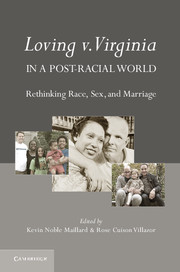Book contents
- Frontmatter
- Contents
- About the Contributors
- Acknowledgments
- Foreword
- Introduction Loving v. Virginia in a Post-Racial World
- Part One Explaining Loving v. Virginia
- Part Two Historical Antecedents to Loving
- 2 Telling Stories of Love, Sex, and Race
- 3 Loving in Indian Territory
- 4 American Mestizo
- 5 Perez v. Sharp and the Limits of Loving
- Part Three Loving and Interracial Relationships: Contemporary Challenges
- Part Four Considering the Limits of Loving
- Part Five Loving Outside the U.S. Borders
- Part Six Loving and Beyond: Marriage, Intimacy, and Diverse Relationships
- Permission Granted
- Index
- References
5 - Perez v. Sharp and the Limits of Loving
Published online by Cambridge University Press: 05 July 2012
- Frontmatter
- Contents
- About the Contributors
- Acknowledgments
- Foreword
- Introduction Loving v. Virginia in a Post-Racial World
- Part One Explaining Loving v. Virginia
- Part Two Historical Antecedents to Loving
- 2 Telling Stories of Love, Sex, and Race
- 3 Loving in Indian Territory
- 4 American Mestizo
- 5 Perez v. Sharp and the Limits of Loving
- Part Three Loving and Interracial Relationships: Contemporary Challenges
- Part Four Considering the Limits of Loving
- Part Five Loving Outside the U.S. Borders
- Part Six Loving and Beyond: Marriage, Intimacy, and Diverse Relationships
- Permission Granted
- Index
- References
Summary
At the center of In re Marriage Cases, the 2008 California Supreme Court decision that attracted national attention for temporarily extending marriage rights to same-sex couples, was a little-known 1948 case called Perez v. Sharp. The first post-Reconstruction case to invalidate an antimiscegenation law, Perez involved plaintiffs who were as courageous as any involved in landmark civil rights cases. Andrea Perez, the daughter of Mexican immigrants, and Sylvester Davis, the product of African-American migrants from the deep South, met while working on an assembly line in World War II, Los Angeles. They fell in love and decided to marry. But when the couple went to get a marriage license, the county clerk informed them that Andrea could not legally marry a black man. California’s antimiscegenation law technically did not constrain the marriage choices of Mexican Americans. In fact, it made no mention of them at all. But, in California, Mexicans had long been regarded as white and thus prohibited from marrying African Americans, among other groups.
With the aid of a civil rights attorney, Dan Marshall, Andrea and Sylvester decided to fight the clerk’s refusal to issue them a marriage license, putting together a legal case that would shake the foundations of California’s carefully constructed racial hierarchy and ultimately pave the way for the U.S. Supreme Court’s decision in Loving v. Virginia nearly twenty years later. Outside the small community of lawyers and activists who, in recent years, have relied on Perez in litigating cases seeking to secure equal marriage rights for gay and lesbian couples, few people have even heard of Andrea and Sylvester or the important legal decision their case produced. For the most part, Perez’s greatest claim to fame has been a footnote mention in Chief Justice Warren’s much-celebrated majority opinion in Loving. To the extent it has been considered at all, it has primarily been treated as a stepping-stone to the Loving decision, as a case that merely underscores Loving’s core holding, not one capable of communicating important lessons in its own right.
- Type
- Chapter
- Information
- Loving v. Virginia in a Post-Racial WorldRethinking Race, Sex, and Marriage, pp. 73 - 88Publisher: Cambridge University PressPrint publication year: 2012



